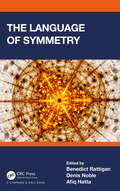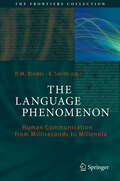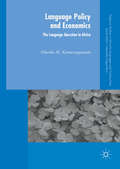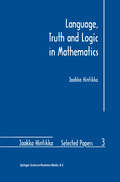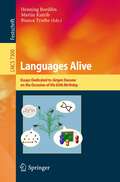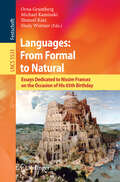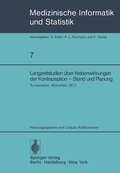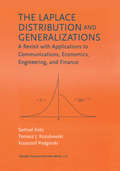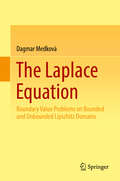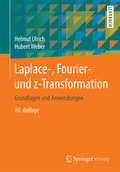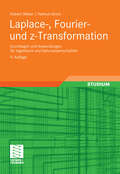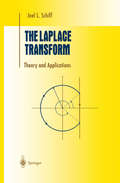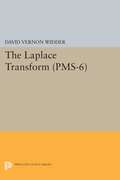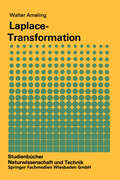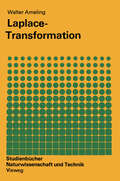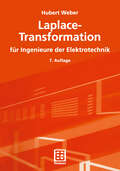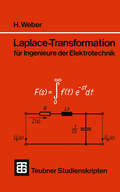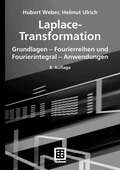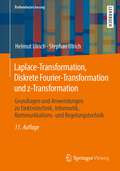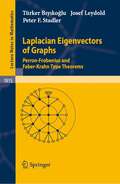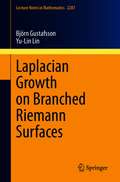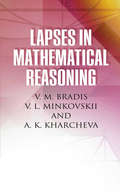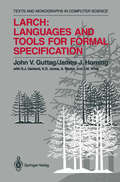- Table View
- List View
The Language of Symmetry
by Benedict Rattigan, Denis Noble and Afiq HattaThe Language of Symmetry is a re-assessment of the structure and reach of symmetry, by an interdisciplinary group of specialists from the arts, humanities, and sciences at Oxford University.It explores, amongst other topics: order and chaos in the formation of planetary systems entropy and symmetry in physics group theory, fractals, and self-similarity symmetrical structures in western classical music how biological systems harness disorder to create order This book aims to open up the scope of interdisciplinary work in the study of symmetry and is intended for scholars of any background - whether it be science, arts, or philosophy.
The Language of Symmetry
by Denis Noble Benedict Rattigan Afiq HattaThe Language of Symmetry is a re-assessment of the structure and reach of symmetry, by an interdisciplinary group of specialists from the arts, humanities, and sciences at Oxford University.It explores, amongst other topics: order and chaos in the formation of planetary systems entropy and symmetry in physics group theory, fractals, and self-similarity symmetrical structures in western classical music how biological systems harness disorder to create order This book aims to open up the scope of interdisciplinary work in the study of symmetry and is intended for scholars of any background - whether it be science, arts, or philosophy.
The Language Phenomenon: Human Communication from Milliseconds to Millennia (The Frontiers Collection)
by P.-M. Binder and K. SmithThis volume contains a contemporary, integrated description of the processes of language. These range from fast scales (fractions of a second) to slow ones (over a million years). The contributors, all experts in their fields, address language in the brain, production of sentences and dialogues, language learning, transmission and evolutionary processes that happen over centuries or millenia, the relation between language and genes, the origins of language, self-organization, and language competition and death. The book as a whole will help to show how processes at different scales affect each other, thus presenting language as a dynamic, complex and profoundly human phenomenon.
Language Policy and Economics: The Language Question in Africa (Palgrave Studies in Minority Languages and Communities)
by Nkonko M. KamwangamaluThis book addresses the perennial question of how to promote Africa’s indigenous languages as medium of instruction in educational systems. Breaking with the traditional approach to the continent’s language question by focusing on the often overlooked issue of the link between African languages and economic development, Language Policy and Economics argues that African languages are an integral part of a nation’s socio-political and economic development. Therefore, the book argues that any language policy designed to promote these languages in such higher domains as the educational system in particular must have economic advantages if the intent is to succeed, and proposes Prestige Planning as the way to address this issue. The proposition is a welcome break away from language policies which pay lip-service to the empowerment of African languages while, by default, strengthening the stranglehold of imported European languages.
Language, Truth and Logic in Mathematics (Jaakko Hintikka Selected Papers #3)
by Jaakko HintikkaOne can distinguish, roughly speaking, two different approaches to the philosophy of mathematics. On the one hand, some philosophers (and some mathematicians) take the nature and the results of mathematicians' activities as given, and go on to ask what philosophical morals one might perhaps find in their story. On the other hand, some philosophers, logicians and mathematicians have tried or are trying to subject the very concepts which mathematicians are using in their work to critical scrutiny. In practice this usually means scrutinizing the logical and linguistic tools mathematicians wield. Such scrutiny can scarcely help relying on philosophical ideas and principles. In other words it can scarcely help being literally a study of language, truth and logic in mathematics, albeit not necessarily in the spirit of AJ. Ayer. As its title indicates, the essays included in the present volume represent the latter approach. In most of them one of the fundamental concepts in the foundations of mathematics and logic is subjected to a scrutiny from a largely novel point of view. Typically, it turns out that the concept in question is in need of a revision or reconsideration or at least can be given a new twist. The results of such a re-examination are not primarily critical, however, but typically open up new constructive possibilities. The consequences of such deconstructions and reconstructions are often quite sweeping, and are explored in the same paper or in others.
Languages Alive: Essays dedicated to Jürgen Dassow on the Occasion of His 65th Birthday (Lecture Notes in Computer Science #7300)
by Henning Bordihn Martin Kutrib Bianca TrutheThis festschrift volume, published in honor of Jürgen Dassow on the occasion of his 65th birthday, contains 19 contributions by leading researchers, colleagues, and friends. Covering topics on picture languages, cooperating distributed systems of automata, quantum automata, grammar systems, online computation, word equations, biologically motivated formal systems, controlled derivations, descriptional complexity, as well as 'classical' topics of automata and language theory, the articles presented span the range of the scientific work of Jürgen Dassow.
Languages: Essays Dedicated to Nissim Francez on the Occasion of His 65th Birthday (Lecture Notes in Computer Science #5533)
by Orna Grumberg Michael Kaminski Shmuel Katz Shuly WintnerLangzeitstudien über Nebenwirkungen der Kontrazeption — Stand und Planung: Symposion der Studiengruppe „Nebenwirkungen oraler Kontrazeptiva — Entwicklungsphase“. München, 27. – 29 September 1977 (Medizinische Informatik, Biometrie und Epidemiologie #7)
by U. KellhammerVerhandlungsberichte wissenschaftlicher Symposien sind nicht in al len Fällen eine Publikation wert. Daß wir uns im vorliegenden Fall für eine Publikation entschieden haben, hat eine Reihe gewichtiger Gründe. Die Frage nach mehr oder weniger gravierenden Nebenwirkungen der oralen Kontrazeption ist immens wichtig für alle Frauen. Wenn sich die wissenschaftliche Gynäkologie in der Beurteilung dieser Fragen irrt, wird sie einen starken Vertrauensschwund hinnehmen müssen. Auch der Staat, der die Bürger nicht hinreichend orientiert und schützt, ist bei einer so weitreichenden Frage der Volksgesundheit zumindest indirekt betroffen. Nebenwirkungen treten erst im fortgeschrittenen Alter mit einer Ver zögerung von mehr als einem Jahrzehnt auf. Die deutsche weibliche Be vö1kerung wächst in den nächsten 10 Jahren in diese Risikosituation voll hinein. Bisher sind noch ca. 40% der weiblichen Bevölkerung ab 35 Jahre ohne Erfahrung mit der Pille. In 10 Jahren werden nahezu alle Frauen die Pille mehr oder weniger lange genommen haben. Wenn gravierende Langzeit-Nebenwirkungen vorhanden sind, muß das Netz der Untersuchungen, um sie möglichst rechtzeitig zu erkennen, jetzt ge spannt werden. Großstudien lassen sich nicht sofort aus dem Boden stampfen. Sie er fordern eine mehr oder weniger lange Entwicklungsphase. Die Entwick lungsphase zu einer deutschen Langzeitstudie, über die hier berich tet werden soll, dauert nunmehr drei Jahre. Die Erfahrungen einer Entwicklungsphase sind für andere derartige Projekte sicher wertvoll. Teil der Strategie von Entwicklungsphasen für Großstudien auf epide miologischem Sektor ist die Einbeziehung internationaler Erfahrungen.
The Laplace Distribution and Generalizations: A Revisit with Applications to Communications, Economics, Engineering, and Finance
by Samuel Kotz Tomasz Kozubowski Krzystof PodgorskiThis book describes the inferential and modeling advantages that this distribution, together with its generalizations and modifications, offers. The exposition systematically unfolds with many examples, tables, illustrations, and exercises. A comprehensive index and extensive bibliography also make this book an ideal text for a senior undergraduate and graduate seminar on statistical distributions, or for a short half-term academic course in statistics, applied probability, and finance.
The Laplace Equation: Boundary Value Problems on Bounded and Unbounded Lipschitz Domains
by Dagmar MedkováThis book is devoted to boundary value problems of the Laplace equation on bounded and unbounded Lipschitz domains. It studies the Dirichlet problem, the Neumann problem, the Robin problem, the derivative oblique problem, the transmission problem, the skip problem and mixed problems. It also examines different solutions - classical, in Sobolev spaces, in Besov spaces, in homogeneous Sobolev spaces and in the sense of non-tangential limit. It also explains relations between different solutions. The book has been written in a way that makes it as readable as possible for a wide mathematical audience, and includes all the fundamental definitions and propositions from other fields of mathematics. This book is of interest to research students, as well as experts in partial differential equations and numerical analysis.
Laplace-, Fourier- und z-Transformation: Grundlagen und Anwendungen
by Helmut Ulrich Hubert WeberDieses Buch ist eine leicht verständliche Einführung in die Theorie und die praktische Handhabung der Fourier-, Laplace- und z-Transformation mit zahlreichen Beispielen und Aufgaben. Der Umgang mit den Transformationen wird ausführlich erläutert und soweit möglich, durch graphische Darstellungen veranschaulicht. Während die Fourier-Transformation vor allem für die Frequenzanalyse verwendet wird, stellt die Laplace-Transformation ein geradezu ideales Werkzeug dar, um lineare Signale und Systeme zu beschreiben und zu berechnen.Das Pendant zur Laplace-Transformation ist die z-Transformation, mit der diskrete Signale und Systeme beschrieben werden, wie z. B. die Abtastung und Diskretisierung von Signalen.Durch die didaktische Darstellung ist ein nachhaltiger Lernerfolg bei den Lesern sicher gestellt, sowie ein erfolgreicher Umgang in der Praxis gewährleistet.
Laplace-, Fourier- und z-Transformation: Grundlagen und Anwendungen für Ingenieure und Naturwissenschaftler
by Hubert Weber Helmut UlrichDieses Buch ist eine leicht zugängliche Einführung in die Theorie und praktische Handhabung der Laplace-, Fourier- und z-Transformation. Während Fourier-Reihe und Fourier-Transformation hauptsächlich zur Darstellung des Frequenzverhaltens von Signalen und Systemen eingesetzt wird, können mit der Laplace-Transformation lineare Differentialgleichungen gelöst und umfassende zeitkontinuierliche Signal- und Systemuntersuchungen durchgeführt werden. Die z-Transformation wird zur Lösung von linearen Differenzengleichungen und zur Beschreibung diskreter Signale und Systeme verwendet. So werden beispielsweise lineare Differentialgleichungen des Zeitbereiches durch L-Transformation zu algebraischen Gleichungen des Bildbereiches, die wesentlich einfacher zu lösen sind. In gleicher Weise vereinfacht die z-Transformation die Behandlung linearer Differenzengleichungen zu algebraischen Gleichungen. Die Verwendung von Korrespondenztabellen und Transformationsregeln eröffnet einen einfachen Weg, die transformierten Funktionen bzw. deren Lösungen wieder im ursprünglichen Zeitbereich zu erhalten. Durch diesen Vorteil erlangten diese Transformationen ihre Bedeutung auf vielen Gebieten, wie beispielsweise der Elektrotechnik, der Signalverarbeitung, der Systemtheorie, der Informationstechnik und der Regelungstechnik. Das Buch bildet ein Fundament für weitergehende, spezielle Probleme und Anwendungen aus diesem Themenkreis.
The Laplace Transform: Theory and Applications (Undergraduate Texts in Mathematics)
by Joel L. SchiffThe Laplace transform is a wonderful tool for solving ordinary and partial differential equations and has enjoyed much success in this realm. With its success, however, a certain casualness has been bred concerning its application, without much regard for hypotheses and when they are valid. Even proofs of theorems often lack rigor, and dubious mathematical practices are not uncommon in the literature for students. In the present text, I have tried to bring to the subject a certain amount of mathematical correctness and make it accessible to un dergraduates. Th this end, this text addresses a number of issues that are rarely considered. For instance, when we apply the Laplace trans form method to a linear ordinary differential equation with constant coefficients, any(n) + an-lY(n-l) + · · · + aoy = f(t), why is it justified to take the Laplace transform of both sides of the equation (Theorem A. 6)? Or, in many proofs it is required to take the limit inside an integral. This is always fraught with danger, especially with an improper integral, and not always justified. I have given complete details (sometimes in the Appendix) whenever this procedure is required. IX X Preface Furthermore, it is sometimes desirable to take the Laplace trans form of an infinite series term by term. Again it is shown that this cannot always be done, and specific sufficient conditions are established to justify this operation.
Laplace Transform (PMS-6)
by David Vernon WidderBook 6 in the Princeton Mathematical Series.Originally published in 1941.The Princeton Legacy Library uses the latest print-on-demand technology to again make available previously out-of-print books from the distinguished backlist of Princeton University Press. These editions preserve the original texts of these important books while presenting them in durable paperback and hardcover editions. The goal of the Princeton Legacy Library is to vastly increase access to the rich scholarly heritage found in the thousands of books published by Princeton University Press since its founding in 1905.
Laplace-Transformation: für Ingenieure der Elektrotechnik (Teubner Studienbücher Technik)
by Hubert WeberBei der Laplace-Transformation wird eine Originalfunktion im reellen Zeitbereich in eine zugehörige Bildfunktion im komplexen Bildbereich transformiert. Die wichtigste Eigenschaft dieser Transformation im Hinblick auf ihre Anwendung besteht darin, dass den schwierigeren Operationen des Differenzierens und Integrierens im Originalbereich einfache algebraische Operationen im Bildbereich entsprechen. Die Laplace-Transformation wird im Sinne einer Einführung in ihrer Theorie und ihrer Anwendung dargestellt. Dabei werden Grundkenntnisse der Analysis vorausgesetzt. Die Laplace-Transformation wird, zugeschnitten auf die Aufgaben der Elektrotechniker in der Praxis, als Teil der Mathematik behandelt. Das Buch bildet zugleich eine Grundlage für weitergehende Studien.
Laplace-Transformation: für Ingenieure der Elektrotechnik (Teubner Studienskripte Technik)
by Hubert WeberLaplace-Transformation: Grundlagen - Fourierreihen und Fourierintegral - Anwendungen
by Hubert Weber Helmut UlrichBei der Laplace-Transformation wird eine Originalfunktion im reellen Zeitbereich in eine zugehörige Bildfunktion im komplexen Bildbereich transformiert. Die wichtigste Eigenschaft dieser Transformation im Hinblick auf ihre Anwendung besteht darin, dass den schwierigeren Operationen des Differenzierens und Integrierens im Originalbereich einfache algebraische Operationen im Bildbereich entsprechen. Die Laplace-Transformation wird im Sinne einer Einführung in ihrer Theorie und ihrer Anwendung dargestellt. Dabei werden Grundkenntnisse der Analysis vorausgesetzt. Die Laplace-Transformation wird, zugeschnitten auf die Aufgaben der Elektrotechniker in der Praxis, als Teil der Mathematik behandelt. Das Buch bildet zugleich eine Grundlage für weitergehende Studien. Die 8. Auflage enthält u.a. Ergänzungen zu LTI-Systemen und zum Arbeiten mit Blockdiagrammen im Abschnitt Anwendungen der Laplace-Transformation sowie Erweiterungen für Maschinenbauer zur Regelungstechnik.
Laplace-Transformation, Diskrete Fourier-Transformation und z-Transformation: Grundlagen und Anwendungen zu Elektrotechnik, Informatik, Kommunikations- und Regelungstechnik
by Helmut Ulrich Stephan UlrichDieses Buch ist eine leicht verständliche Einführung in die Theorie und praktische Handhabung der Laplace-, Fourier- und z-Transformation, die in vielen Fachgebieten wie der Elektrotechnik , Informations- und Kommunikationstechnik, Mechatronik, Regelungstechnik etc. eine wichtige Rolle spielen. Zahlreiche Beispiele und Anwendungen zeigen den richtigen Umgang mit den Transformationen. Die Erläuterungen werden vielfach durch graphische Darstellungen veranschaulicht. Das Ziel des Buches ist es, eigene Problemstellungen mit den gezeigten Methoden erfolgreich angehen zu können. Die didaktische Aufbereitung des Lehrstoffes im Buch sichert einen nachhaltigen Lernerfolg .
Laplacian Eigenvectors of Graphs: Perron-Frobenius and Faber-Krahn Type Theorems (Lecture Notes in Mathematics #1915)
by Türker Biyikoglu Josef Leydold Peter F. StadlerThis fascinating volume investigates the structure of eigenvectors and looks at the number of their sign graphs ("nodal domains"), Perron components, and graphs with extremal properties with respect to eigenvectors. The Rayleigh quotient and rearrangement of graphs form the main methodology. Eigenvectors of graph Laplacians may seem a surprising topic for a book, but the authors show that there are subtle differences between the properties of solutions of Schrödinger equations on manifolds on the one hand, and their discrete analogs on graphs.
Laplacian Growth on Branched Riemann Surfaces (Lecture Notes in Mathematics #2287)
by Björn Gustafsson Yu-Lin LinThis book studies solutions of the Polubarinova–Galin and Löwner–Kufarev equations, which describe the evolution of a viscous fluid (Hele-Shaw) blob, after the time when these solutions have lost their physical meaning due to loss of univalence of the mapping function involved. When the mapping function is no longer locally univalent interesting phase transitions take place, leading to structural changes in the data of the solution, for example new zeros and poles in the case of rational maps. This topic intersects with several areas, including mathematical physics, potential theory and complex analysis. The text will be valuable to researchers and doctoral students interested in fluid dynamics, integrable systems, and conformal field theory.
Lapses in Mathematical Reasoning (Dover Books on Mathematics)
by A. K. Kharcheva L. Minkovskii V. M. BradisDesigned as a method for teaching correct mathematical thinking to high school students, this book contains a brilliantly constructed series of what the authors call "lapses," erroneous statements that are part of a larger mathematical argument. These lapses lead to sophism or mathematical absurdities. The ingenious idea behind this technique is to lead the student deliberately toward a clearly false conclusion. The teacher and student then go back and analyze the lapse as a way to correct the problem.The authors begin by focusing on exercises in refuting erroneous mathematical arguments and their classification. The remaining chapters discuss examples of false arguments in arithmetic, algebra, geometry, trigonometry, and approximate computations. Ideally, students will come to the correct insights and conclusions on their own; however, each argument is followed by a detailed analysis of the false reasoning. Stimulating and unique, this book is an intriguing and enjoyable way to teach students critical mathematical reasoning skills.
Larch: Languages and Tools for Formal Specification (Monographs in Computer Science)
by John V. Guttag James J. HorningBuilding software often seems harder than it ought to be. It takes longer than expected, the software's functionality and performance are not as wonderful as hoped, and the software is not particularly malleable or easy to maintain. It does not have to be that way. This book is about programming, and the role that formal specifications can play in making programming easier and programs better. The intended audience is practicing programmers and students in undergraduate or basic graduate courses in software engineering or formal methods. To make the book accessible to such an audience, we have not presumed that the reader has formal training in mathematics or computer science. We have, however, presumed some programming experience. The roles of fonnal specifications Designing software is largely a matter of combining, inventing, and planning the implementation of abstractions. The goal of design is to describe a set of modules that interact with one another in simple, well defined ways. If this is achieved, people will be able to work independently on different modules, and yet the modules will fit together to accomplish the larger purpose. In addition, during program maintenance it will be possible to modify a module without affecting many others. Abstractions are intangible. But they must somehow be captured and communicated. That is what specifications are for. Specification gives us a way to say what an abstraction is, independent of any of its implementations.
Large Coulomb Systems: Lecture Notes on Mathematical Aspects of QED (Lecture Notes in Physics #695)
by Jan Derezinski Heinz SiedentopA mathematically consistent formulation of relativistic quantum electrodynamics (QED) has still to be found. Nevertheless, there are several simplified effective models that successfully describe many body quantum systems and the interaction of radiation with matter. Large Coulomb Systems explores a selection of mathematical topics inspired by QED. It comprises selected, expanded and edited lectures given by international experts at a topical summer school.
